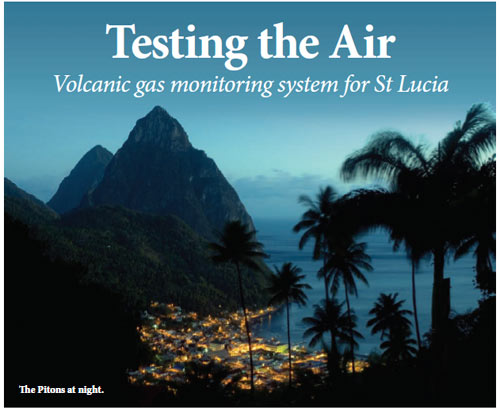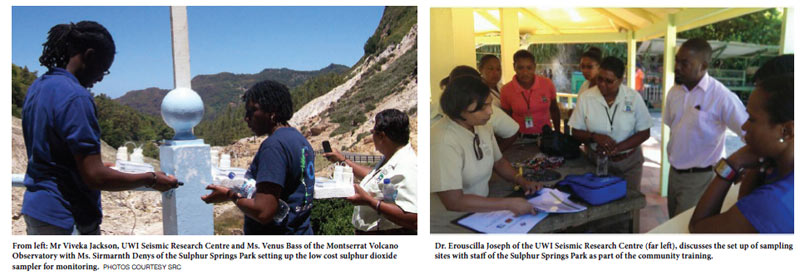
When you think of St Lucia’s landscape, the magnificent Pitons come easily to mind. The Gros Piton and the Petit Piton are the two volcanic plugs located to the south of Soufrière. They are recognised as one of UNESCO’s World Heritage Sites and attract many visitors. The town of Soufrière with a population just under 8,400, attracts many tourists – Sulphur Springs Park draws more than 200,000 annually.
But the volcanic landscape, while it provides a livelihood for many St Lucians, also has a life of its own, which might not necessarily be good for residents and visitors.
Volcanic gases, present even in a passive volcano can be damaging to health, and there has been some concern over what levels exist and how harmful they might be.
In this case, stakeholders from Saint Lucia’s health and environmental sectors convened at the Soufrière Community Access Centre for the launch of a new network to monitor these gases.
Led by The UWI Seismic Research Centre (UWI-SRC), the primary objective of the project is to gain a better understanding of volcanic emissions at the Soufrière Volcano and the potential impact on environmental and human health.
The UWI-SRC and members of the Project Team will work with the Soufrière Regional Development Foundation (SRDF), management of the Sulphur Springs Park, and NEMO of Saint Lucia, to establish a volcanic emissions monitoring network at two sites affected by geothermal activity.
The project will specifically measure outputs of sulphur dioxide in the air and arsenic in water at the Sulphur Springs Park and the town of Soufrière. The eight month project also seeks to build local capacity as members of the SRDF will be trained in the application of low-cost, low-technology monitoring techniques developed by the UWI Department of Chemistry in St. Augustine.
“The involvement of the community through the training is an important component of the project as it will improve and expand our capacity to provide volcanic monitoring of gases beyond the life of the project,” said the Principal Investigator on the project, Dr. Erouscilla Joseph, a Volcanologist at the UWI-SRC.
By the end of 18 months, she envisages that the main outcomes would be: 1) quantification of the chemical impacts of volcanism on SO2 in the air, and arsenic in the water supplies of Sulphur Springs and Soufrière; 2) Provide a low-cost low-technology SO2 monitoring technique as an option for use in reducing the impacts of passive volcanic emissions on human health; 3) Promote knowledge transfer of technology, and increase the capacity of local personnel by training them to perform SO2 evaluations; 4) Contribute to advancing the knowledge and understanding of volcanic emissions and their potential impacts on the local environment, and hazards to human health through publications in international, peer-reviewed journals; and 5) Promote public education about the risks associated with exposure to unsafe levels of volcanic emissions and steps that may be taken to reduce these risks.
Similar networks have been established in Hawaii and Reunion Island in the Indian Ocean but this is the first of its kind in the Caribbean and it will be used as a model for other volcanic islands in the region.
The project is funded by The UWI Trinidad and Tobago Research and Development Impact Fund (RDI) and project partners include the Department of Chemistry (UWI St. Augustine), The Soufrière Regional Development Foundation, the Saint Lucia National Emergency Management Organisation and the Montserrat Volcano Observatory.

|





